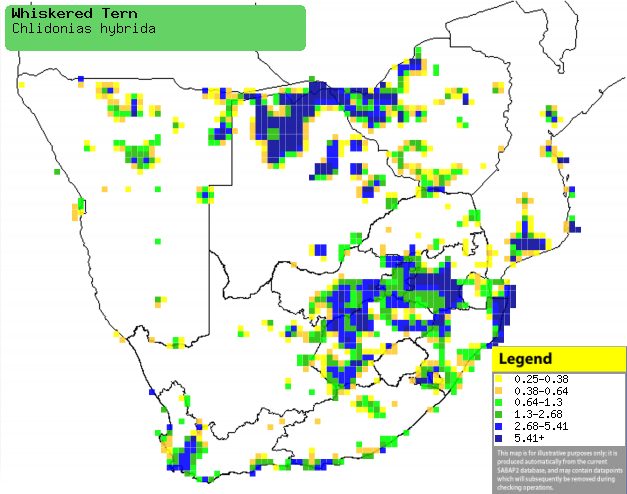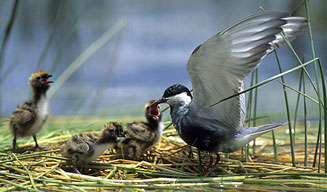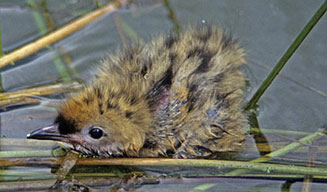|
Chlidonias hybrida (Whiskered tern)
Witbaardsterretjie [Afrikaans]; Witwangstern [Dutch];
Guifette moustac [French]; Weißbart-seeschwalbe [German];
Gaivina-de-faces-brancas [Portuguese]
Life
> Eukaryotes >
Opisthokonta
> Metazoa (animals) >
Bilateria >
Deuterostomia > Chordata >
Craniata > Vertebrata (vertebrates) > Gnathostomata (jawed
vertebrates) > Teleostomi (teleost fish) > Osteichthyes (bony fish) > Class:
Sarcopterygii (lobe-finned
fish) > Stegocephalia (terrestrial
vertebrates) > Tetrapoda
(four-legged vertebrates) > Reptiliomorpha > Amniota >
Reptilia (reptiles) >
Romeriida > Diapsida > Archosauromorpha > Archosauria >
Dinosauria
(dinosaurs) > Saurischia > Theropoda (bipedal predatory dinosaurs) >
Coelurosauria > Maniraptora > Aves
(birds) > Order: Charadriiformes
> Family: Laridae > Genus: Chlidonias
Distribution and habitat
Occurs discontinuously from western Europe to eastern China
and Russia south to Australia and sub-Saharan Africa, where it is largely absent from the lowland forest of the DRC and
West Africa. Here it is locally fairly
common in northern Namibia (including the Caprivi Strip), northern and eastern
Botswana, western and southern Zimbabwe, southern Mozambique and central and
south-western South Africa. It generally prefers natural wetlands, especially
vleis, marshes and river flood plains with emergent vegetation, mainly breeding on
temporary marshes and farm dams.
|
 |
|
Distribution of Whiskered tern in southern Africa,
based on statistical smoothing of the records from first SA Bird Atlas
Project (©
Animal Demography unit, University of
Cape Town; smoothing by Birgit Erni and Francesca Little). Colours range
from dark blue (most common) through to yellow (least common).
See here for the latest distribution
from the SABAP2. |
Predators and parasites
Movements and migrations
Breeding summer migrant to north-central
Namibia, Zimbabwe, the South African highveld, the Western Cape and the
Eastern Cape. It is largely resident in Botswana, north-western
Zimbabwe and the tropical lowlands of Mozambique and KwaZulu-Natal.
Food
It mainly eats small fish, amphibians including Arum lily
frogs (Hyperolius horstockii) plucked from Arum lilies (Zantedeschia
aethiopica), insects and other invertebrates. It does most of its foraging
in loose flocks, flying up wind, 2-4 metres above water.
Breeding
- Monogamous colonial nester, breeding in colonies of 5-30, rarely 60-80 pairs
spread 2-20 metres apart. It is an opportunistic breeder, with laying dates
often synchronised within the colony, as they all lay straight after heavy
rain.
- The nest (see image below) is built by both sexes, consisting of an
untidy floating structure of plant stems, leaves and sometimes grass, which
an be either flat or higher and more bulky depending on environmental
conditions.
 |
 |
|
Whiskered tern at its nest with chicks,
Wakkerstroom, South Africa. [photo Warwick Tarboton ©] |
Close-up of Whiskered tern chick, Wakkerstroom, South Africa. [photo Warwick Tarboton ©] |
- Egg-laying season is from October-April, peaking from January-March in
most of southern Africa excluding the Western Cape, where egg-laying is
mainly from October-February, peaking from October-November.
- It lays 1-3 eggs, which are incubated by both sexes for about 20 days.
- The chicks can swim soon after hatching, taking to the water if
predators before returning once the danger passes. The adults are
aggressive in defence of their young, often attacking and dive bombing
intruders such as humans. They fledge at about 20-27 days old, soon after
which they start to practice foraging, although still regularly returning to
the nest to be fed.
Threats
Not threatened, although cattle can be a major breeding
disturbance, often causing the abandonment of nests by breeding pairs.
References
-
Hockey PAR, Dean WRJ and Ryan PG 2005. Roberts
- Birds of southern Africa, VIIth ed. The Trustees of the John Voelcker
Bird Book Fund, Cape Town.
|
